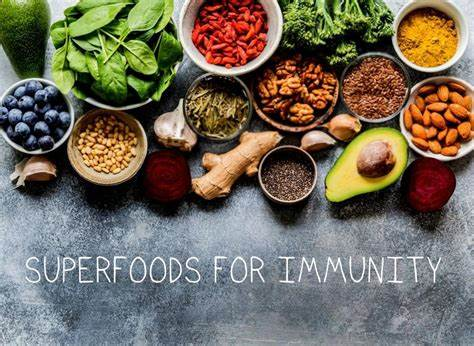
Being immune is the state of having immunity, which is conferred by either an immune response brought on by an infection or immunization, or by other non-immunologic factors. It includes the capacity to recognize to foreign objects as distinct from oneself and to use physiological immune response mechanisms to neutralize, get rid of, or metabolize foreign objects.

SPICES:
The essential spices include ginger, garlic, cumin, fennel, fenugreek, turmeric, cinnamon, and black pepper. They can be used in regular cooking and eaten in dals, vegetables, curries, soups, and other dishes. They can also be boiled to make herbal tea also.
TUMERIC :
 The vibrant yellow spice is used frequently in Indian cooking and in the treatment of many illnesses. Curcumin-rich turmeric is the best ingredient for boosting immunity and treating a variety of inflammatory conditions. Although it can be used in a variety of dishes, the best way to eat it, is in hot milk or as a drink when combined with lemon and water. The active ingredient makes the body’s white blood cells more effective, which improves the body’s antibody response and has anti-inflammatory, anti-aging, antibiotic, and anti-oxidant properties which causes several molecular changes that may aid in the prevention and treatment of cancer. It is advised to take 1-2 gm of curcumin for medicinal purposes. Due to its high potassium content, it is not advised for patients with chronic kidney disease to consume excessive amounts of it. Curcumin is a fat soluble which break down and soluble in fat.But when taken alone it poorly absorbed in the body so its is advised to take curcumin with black pepper as it contain natural compound piperine which increases curcumin absorption by 2000% .That’s why piperine is present in the best curcumin supplements, which significantly increases their potency.
The vibrant yellow spice is used frequently in Indian cooking and in the treatment of many illnesses. Curcumin-rich turmeric is the best ingredient for boosting immunity and treating a variety of inflammatory conditions. Although it can be used in a variety of dishes, the best way to eat it, is in hot milk or as a drink when combined with lemon and water. The active ingredient makes the body’s white blood cells more effective, which improves the body’s antibody response and has anti-inflammatory, anti-aging, antibiotic, and anti-oxidant properties which causes several molecular changes that may aid in the prevention and treatment of cancer. It is advised to take 1-2 gm of curcumin for medicinal purposes. Due to its high potassium content, it is not advised for patients with chronic kidney disease to consume excessive amounts of it. Curcumin is a fat soluble which break down and soluble in fat.But when taken alone it poorly absorbed in the body so its is advised to take curcumin with black pepper as it contain natural compound piperine which increases curcumin absorption by 2000% .That’s why piperine is present in the best curcumin supplements, which significantly increases their potency.
GINGER:
According to Ayurveda, ginger is the best immune system builder and can treat a variety of digestive. Ginger is among the best (and generally delectable) flavors in the world. It has a place with the Zingiberaceae family, and it’s firmly connected with turmeric, cardamom, and galangal.
 Ginger can be utilized new, dried, powdered, or as an oil or squeeze. It’s an exceptionally considered normal fixing in recipes. It’s occasionally added to handled food varieties and cosmetics. Contains gingerol, which has strong therapeutic properties. Ginger has an extremely lengthy history of purpose in different types of conventional and elective medication. It’s been utilized to help processing, lessen sickness, and assist with battling this season’s virus and normal cold. Ginger may help fight dangerous germs and fungus, perhaps lowering your risk of illness.To give some examples of its purposes, the exceptional scent and kind of ginger come from its regular oils, the most significant of which is gingerol .
Ginger can be utilized new, dried, powdered, or as an oil or squeeze. It’s an exceptionally considered normal fixing in recipes. It’s occasionally added to handled food varieties and cosmetics. Contains gingerol, which has strong therapeutic properties. Ginger has an extremely lengthy history of purpose in different types of conventional and elective medication. It’s been utilized to help processing, lessen sickness, and assist with battling this season’s virus and normal cold. Ginger may help fight dangerous germs and fungus, perhaps lowering your risk of illness.To give some examples of its purposes, the exceptional scent and kind of ginger come from its regular oils, the most significant of which is gingerol .
Gingerol is the really bioactive compound in ginger. It’s answerable for a lot of ginger’s restorative properties. Gingerol has strong mitigating and cell reinforcement impacts, as indicated by research For example, it might assist with diminishing oxidative pressure, which is the consequence of having an abundance measure of free extremists in the body. use 1-1.5 grams of ginger can assist with forestalling different sorts of queasiness, including chemotherapy-related sickness, queasiness after medical procedure, and morning sickness. In a 2019 writing survey additionally reasoned that ginger altogether diminished HbA1c in individuals with type 2 diabetes. In any case, it additionally found that ginger affected fasting glucose. Ginger may also help reduce nausea, help you lose weight, lower cholesterol levels, protect nerve function, and lower your risk of cancer. It may also assist in the fight against harmful bacteria and fungi, which may lower your risk of infections.
GARLIC:
Due to its many therapeutic properties, garlic is the most common ingredient used in Indian cuisine. The best way to consume it is to take one clove of crushed garlic with a glass of water first thing in the morning.
 Garlic is loaded with manganese, L-ascorbic acid, selenium, and numerous other nutrients.Garlic is stacked with bioactive mixtures, as allicin, which gives serious areas of strength for it, mitigating, hostile to microbial, and other mending properties.
Garlic is loaded with manganese, L-ascorbic acid, selenium, and numerous other nutrients.Garlic is stacked with bioactive mixtures, as allicin, which gives serious areas of strength for it, mitigating, hostile to microbial, and other mending properties.
Garlic’s sulfur-containing intensifies give it that trademark flavor and odor.tudies proposes of garlic helps support resistance by expanding the quantity of specific safe cells in the body. Furthermore, various preliminaries show garlic diminishes the number, term, and seriousness of colds. Although additional research is required before any conclusions can be drawn, garlic supplements may assist in the prevention and amelioration illnesses such as the common cold and flu. For those who are already diagnosed with hypertension, garlic appears to lower blood pressure at high doses.
Supplements may sometimes perform as well as prescription drugs. Supplements containing garlic appear to lower total cholesterol and LDL (bad) cholesterol, particularly in people with high cholesterol. Triglycerides and HDL (good) cholesterol are not problematic.
It can be consumed raw or added to various dishes and masala tea. appear to be impacted. Antioxidants in garlic can assist in preventing cell damage and aging. It may lower the risk of dementia and Alzheimer’s disease.
CINNAMON:
The inner bark of trees, which is scientifically known as Cinnamomum, is used to make the spice cinnamon.  This spice has antiviral, bacterial, and fungicidal properties. Additionally, the antioxidant and anti-inflammatory properties of the ingredient safeguard your body from disease.
This spice has antiviral, bacterial, and fungicidal properties. Additionally, the antioxidant and anti-inflammatory properties of the ingredient safeguard your body from disease.
It also helps to lower blood sugar levels, reduce the risk of type 2 diabetes, and improve gut health. Sticks or powder can be used in desserts, dishes, warm water, and tea. Cinnamon has also been used for its therapeutic properties since ancient times. It repairs damaged tissues, prevents infection, and reduces inflammation. Cinnamon has anti-diabetic properties, is high in antioxidants that strengthen the immune system, and may even lower the risk of heart disease.Cinnamaldehyde is one of the most important active ingredients in cinnamon. Flavorings and fragrances make use of it. It very well might be liable for a portion of cinnamon’s conceivable medical advantages.
BLACK PEPPER:
BLACK PEPPER is a crucial spice because of its anti-inflammatory, antimicrobial, and gastroprotective properties. It can be used in tea, salads, curd, and tea. Piperine, the plant compound in dark pepper, areas of strength for has properties.
 The body makes free revolutionaries, temperamental particles that can harm cells, both normally and because of ecological burdens. Abundance free extreme harm can prompt serious medical issues, including fiery sicknesses, coronary illness, and certain tumors.
The body makes free revolutionaries, temperamental particles that can harm cells, both normally and because of ecological burdens. Abundance free extreme harm can prompt serious medical issues, including fiery sicknesses, coronary illness, and certain tumors.
Another rat study recommends piperine’s calming properties might assist with safeguarding renal tissue harm related with ischemia-reperfusion. Ischemia-reperfusion alludes to tissue harm that happens when a piece of the body doesn’t get sufficient oxygen. Scientists have additionally found that particular piperine enhancements might help decline the constant inflammation that individuals with metabolic disorder insight, however more human exploration is fundamental. Research has demonstrated the way that consumes less calories high in cancer prevention agents could reduce free extreme harm. For instance, one review of both test cylinder and rat investigations discovered that dark pepper and piperine enhancements might forestall or slow the headway of free extreme harm and related infections like atherosclerosis, diabetes, and disease.
CUMIN:
Cumin is a spice derived from the seeds of the plant Cuminum cyminum. Cumin is used in many recipes, particularly those from its home countries of the Mediterranean and Southwest Asia. Flavonoids, which are found in cumin, are antioxidants that have been shown to lower blood pressure, fight cancer, and prevent heart disease. Additionally helpful for weight loss, it has antibacterial qualities and enhances digestion. One teaspoon of cumin contains almost 20% of your daily iron needs, making it a very rich source of iron.
Flavonoids, which are found in cumin, are antioxidants that have been shown to lower blood pressure, fight cancer, and prevent heart disease. Additionally helpful for weight loss, it has antibacterial qualities and enhances digestion. One teaspoon of cumin contains almost 20% of your daily iron needs, making it a very rich source of iron.
Both the whole seeds and the powder can be used as seasoning. It’s beneficial to soak one teaspoon overnight and consume it in the morning. Cumin contains bunches of plant intensifies that are connected with potential medical advantages, including terpenes, phenols, flavonoids and alkaloids. Cumin releases megalomicin, an antibiotic-like component, when it is digested. Free radicals are single electrons that damage DNA and cause inflammation. Antioxidants in cumin stabilize free radicals and may reduce food-borne illnesses and improve blood sugar control.
Analysts have assessed cumin remove for treating the issues, stomach related fits, sickness, and swelling related with crabby inside disorder (IBS).. Cumin is so effective that researchers believe it could be a good alternative for people who can’t afford expensive IBS medications though study were still going on.
REFERENCE:
Agah S, Taleb AM, Moeini R, Gorji N, Nikbakht H. Cumin extract for symptom control in patients with irritable bowel syndrome: a case series. Middle East J Dig Dis. 2013 Oct;5(4):217-22. PMID: 24829694; PMCID: PMC3990147.
Ancuceanu R, Dinu M, Hovaneţ MV, Anghel AI, Popescu CV, Negreş S. A Survey of Plant Iron Content-A Semi-Systematic Review. Nutrients. 2015 Dec 10;7(12):10320-51. doi: 10.3390/nu7125535. PMID: 26690470; PMCID: PMC4690087.
Arreola R, Quintero-Fabián S, López-Roa RI, Flores-Gutiérrez EO, Reyes-Grajeda JP, Carrera-Quintanar L, Ortuño-Sahagún D. Immunomodulation and anti-inflammatory effects of garlic compounds. J Immunol Res. 2015;2015:401630. doi: 10.1155/2015/401630. Epub 2015 Apr 19. PMID: 25961060; PMCID: PMC4417560.
Ballester P, Cerdá B, Arcusa R, Marhuenda J, Yamedjeu K, Zafrilla P. Effect of Ginger on Inflammatory Diseases. Molecules. 2022 Oct 25;27(21):7223. doi: 10.3390/molecules27217223. PMID: 36364048; PMCID: PMC9654013.
Bettaieb I, Bourgou S, Wannes WA, Hamrouni I, Limam F, Marzouk B. Essential oils, phenolics, and antioxidant activities of different parts of cumin (Cuminum cyminum L.). J Agric Food Chem. 2010 Oct 13;58(19):10410-8. doi: 10.1021/jf102248j. PMID: 20809647.
Borlinghaus J, Albrecht F, Gruhlke MC, Nwachukwu ID, Slusarenko AJ. Allicin: chemistry and biological properties. Molecules. 2014 Aug 19;19(8):12591-618. doi: 10.3390/molecules190812591. PMID: 25153873; PMCID: PMC6271412.
Gunawardena D, Karunaweera N, Lee S, van Der Kooy F, Harman DG, Raju R, Bennett L, Gyengesi E, Sucher NJ, Münch G. Anti-inflammatory activity of cinnamon (C. zeylanicum and C. cassia) extracts – identification of E-cinnamaldehyde and o-methoxy cinnamaldehyde as the most potent bioactive compounds. Food Funct. 2015 Mar;6(3):910-9. doi: 10.1039/c4fo00680a. PMID: 25629927.
Mnif S, Aifa S. Cumin (Cuminum cyminum L.) from traditional uses to potential biomedical applications. Chem Biodivers. 2015 May;12(5):733-42. doi: 10.1002/cbdv.201400305. PMID: 26010662.
Pandey S, Patel MK, Mishra A, Jha B. Physio-Biochemical Composition and Untargeted Metabolomics of Cumin (Cuminum cyminum L.) Make It Promising Functional Food and Help in Mitigating Salinity Stress. PLoS One. 2015 Dec 7;10(12):e0144469. doi: 10.1371/journal.pone.0144469. PMID: 26641494; PMCID: PMC4671573.
Percival SS. Aged Garlic Extract Modifies Human Immunity. J Nutr. 2016 Feb;146(2):433S-436S. doi: 10.3945/jn.115.210427. Epub 2016 Jan 13. PMID: 26764332.
Prasad S, Tyagi AK. Ginger and its constituents: role in prevention and treatment of gastrointestinal cancer. Gastroenterol Res Pract. 2015;2015:142979. doi: 10.1155/2015/142979. Epub 2015 Mar 8. PMID: 25838819; PMCID: PMC4369959.
Review Nat Prod Commun. 2014 Jul;9(7):1027-30.Biological properties of 6-gingerol: a brief review Shaopeng Wang, Caihua Zhang, Guang Yang, Yanzong Yang PMID: 25230520
Rivlin RS. Historical perspective on the use of garlic. J Nutr. 2001 Mar;131(3s):951S-4S. doi: 10.1093/jn/131.3.951S. PMID: 11238795.
Shan B, Cai YZ, Sun M, Corke H. Antioxidant capacity of 26 spice extracts and characterization of their phenolic constituents. J Agric Food Chem. 2005 Oct 5;53(20):7749-59. doi: 10.1021/jf051513y. PMID: 16190627.
Shavakhi A, Torki M, Khodadoostan M, Shavakhi S. Effects of cumin on nonalcoholic steatohepatitis: A double blind, randomised, controlled trial. Adv Biomed Res. 2015 Sep 28;4:212. doi: 10.4103/2277-9175.166149. PMID: 26605241; PMCID: PMC4627178.
Sowbhagya HB. Chemistry, technology, and nutraceutical functions of cumin (Cuminum cyminum L): an overview. Crit Rev Food Sci Nutr. 2013;53(1):1-10. doi: 10.1080/10408398.2010.500223. PMID: 23035918.
ARTICLE BY
Nutritionist Debjani Mondal
M.sc (food and nutrition), Certified Diabetes Educator.
Nutritionist content writer of TEAM NUTRI WORLD.



